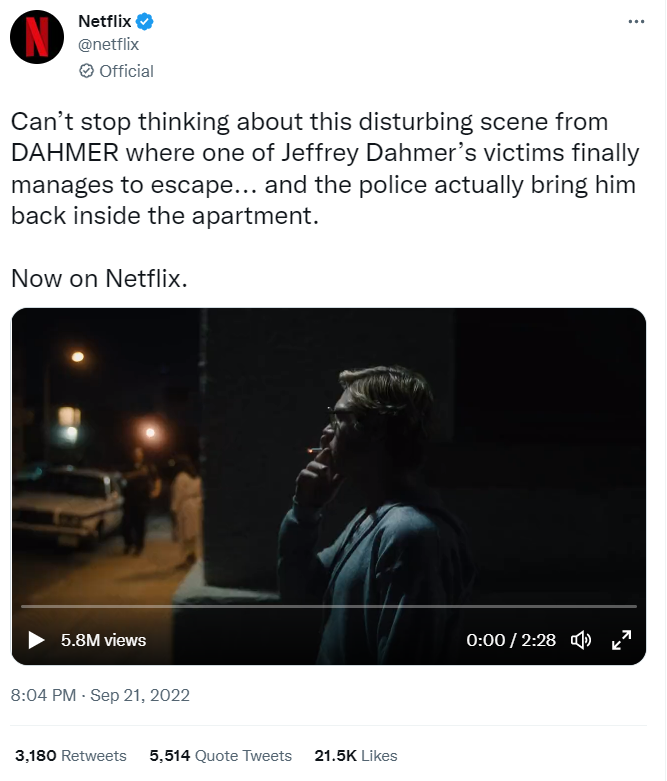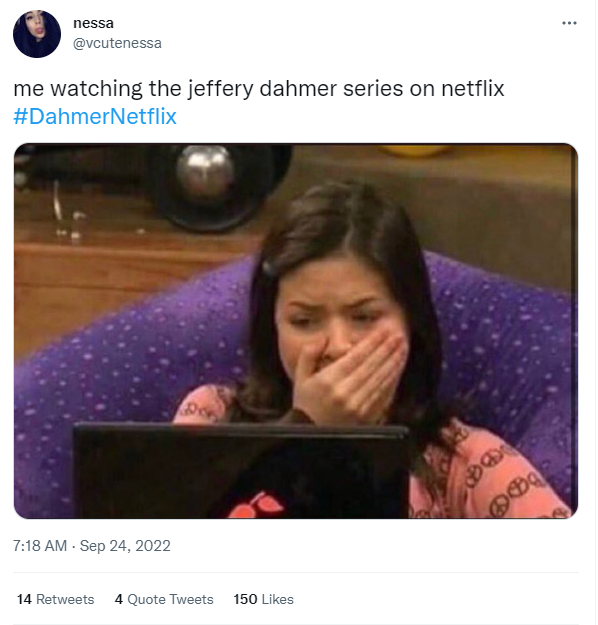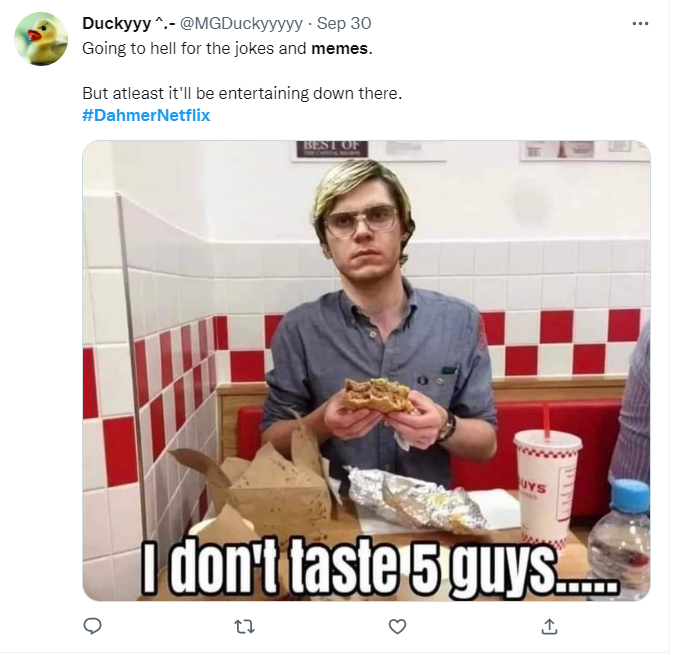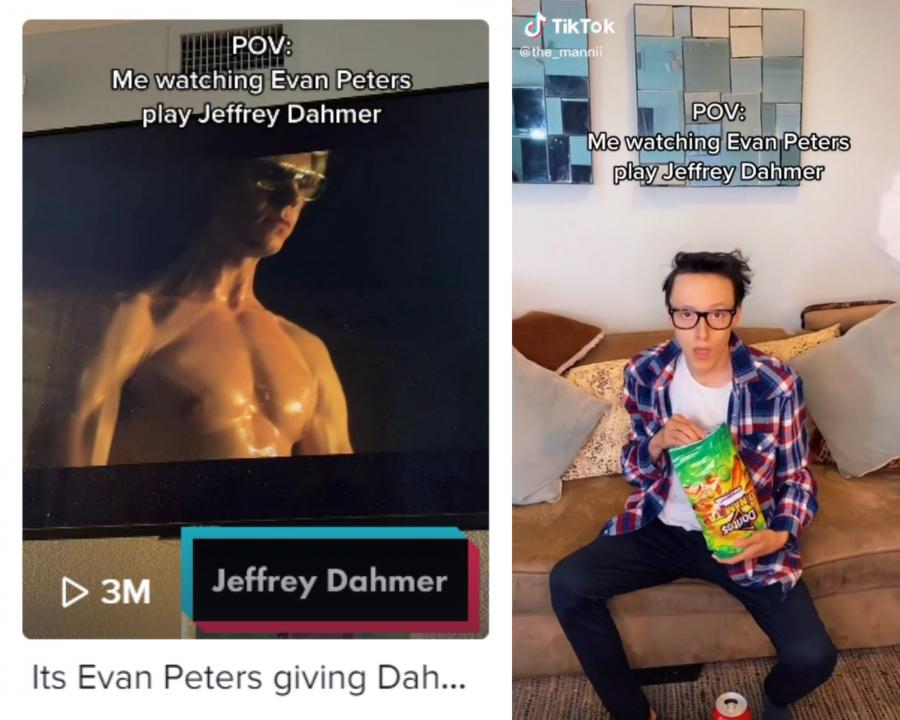
Mixing truth and fiction: Jeffrey Dahmer on Netflix
Jeffrey Dahmer was a cannibalistic serial killer who brutally murdered and sexually assaulted seventeen young men and boys, mostly from Black, Hispanic, or Asian backgrounds. On the 21st of September 2022, Netflix released the first season of his biography: Dahmer – Monster: The Jeffrey Dahmer Story, produced by true crime aficionado Ryan Murphy. The Netflix show explores the motives and murders of Dahmer (played by Evan Peters). It reached the number one spot on Netflix within the first week of its release and is now the second most-viewed English-spoken Netflix series of all time (Tassi, 2022).
Popular yet controversial
Besides amassing popularity, the show also sparked a lot of controversies. Many people have accused the show of being insensitive toward the families of the victims (see Vlamis, 2022). More importantly, the show has faced huge criticism for romanticizing Dahmer and his crimes (see Mishra, 2022). On top of that, Netflix has been scrutinized for presenting real-life crime as entertainment. Particularly after the company posted a tweet on the 21st of September 2022, which commercialized a crime committed by Dahmer (see fig. 1).

Figure 1: Tweet posted by Netflix
Yet, Netflix is not the only contributor to the trivialization of Dahmer. Social media platforms like Twitter and TikTok have seen an upsurge of ‘’Dahmer content’’. Generally, this content jokingly discusses the Netflix show. However, some fans have posted unsettling content, ranging from joking about real-life crimes to confessing one’s love for the serial killer.
This paper analyses the online content that trivializes Jeffrey Dahmer. I will illustrate how classic examples of participatory culture – like memes – can lead to blurred lines between truth and fiction. In addition, I will use Horton & Wohl’s (1956) concept of parasocial relationships to demonstrate how lines between truth and fiction have faded in the case of Dahmer – Monster: The Jeffrey Dahmer Story.
Participatory culture and memes
According to Jenkins (2006), the ability to transform personal reaction into social interaction, and spectatorial culture into participatory culture, is central to ‘’fandom’’. ‘’For fans’’, he says, ‘’consumption naturally sparks production (…)’’ (Jenkins, 2006, p. 41). Fans archive, annotate, appropriate, and recirculate content that they are a fan of. In other words, fans – whether it is from a music artist or TV show - are not just observers, they are participants.
Digital media facilitates this participation. Because of the affordances of digital media, fan communication continues to increase in speed and intensity. Moreover, digital media favours user-generated content, thereby ‘’encouraging the flows of images, ideas, and narratives’’ (Jenkins, 2006, p. 136). In short, in the current digital environment, a more ‘’active mode of spectatorship’’ (Jenkins, 2006, p. 137) is encouraged and facilitated by digital media.
Lynch (2020) reinforces this point. She states that ‘’fans engage with their favourite shows through social media more than anything else’’ (p. 5). Her research focuses on the Netflix original You, a psychological thriller about serial killer Joe Goldberg which caused the internet to explode with memes.
Similar phenomena occur with Dahmer – Monster: The Jeffrey Dahmer Story. Since the show’s release, many memes have been created and circulated online. Like You, the ‘’Dahmer memes’’ functioned as an extension of the show. In both cases, most of the memes had a positive, comedic, and relatable theme (see fig. 2) (Lynch, 2020).

Figure 2: Relatable ''Dahmer meme'' on Twitter
Lynch (2020, p. 21) also demonstrates that ‘’memes and social media, by nature, have a way of romanticizing serial killers or making criminals seem more likeable’’. Furthermore, she states that memes can potentially change audiences' perceptions of serial killers. Memes can thus positively influence audiences’ views on serial killers, which also happened after the first season of You was released. Memes created a romanticized image of serial killer Joe Goldberg and often reframed or downplayed his worst flaws (Lynch, 2020). Interestingly, the same thing happens with Dahmer memes. One big difference between Joe Goldberg and Jeffrey Dahmer, however, is that Goldberg is a completely fictional character, while Dahmer is a real-life serial killer with real-life victims. This raises some problems.
Figure 3 demonstrates the problems that arise with this ‘’memetic romanticization’’. Here, a picture of Evan Peters as Jeffrey Dahmer is edited into the fast-food restaurant Five Guys. The caption says ‘’I don’t taste 5 guys’’, referring to multiple crimes committed by Dahmer that involved cannibalism. The meme turns cannibalism into a joke, thus trivializing the event. Because of the trivialization of such an act, the audience can perceive cannibalism as something funny, thereby skewing their perceptions of Dahmer’s crimes.

Figure 3: Dahmer meme trivializing cannibalism
The connection of offensive memes to a Netflix show warrants their publication
Though Dahmer memes are often based on the Netflix show, they still relate to real-life events. The memes often touch on sensitive subjects, but because the memes are associated with the Netflix show, it is regarded to be significantly less wrong. It is important to note that the creator of this meme is aware of the ethics surrounding his meme. The caption ‘’Going to hell for the jokes and memes (…)’’ illustrates that the creator knows that the meme concerns a sensitive subject. Despite this, the creator still posts the meme. The connection to the Netflix show warrants the publication of such posts. It is evident how, because of the memeification of true crime, the distinction between truth and fiction fades. These memes are more so regarded as a funny extension of the Netflix show, rather than an inappropriate joke about real-life crime.
Secondary attraction and parasocial thirst
In 1956, Horton and Wohl introduced the concept of the parasocial relationship, which is the ‘’seeming face-to-face relationship between spectator and performer’’ (p. 215). Parasocial relationships are characteristic of the new media, where the content presented makes nuances of appearance and gesture present to which ‘’ordinary social perception is attentive and interaction is cued’’ (Horton & Wohl, 1956, p. 215). Parasocial relationships often offer the illusion of an intimate bond between the spectator and performer, which in term causes the spectators to feel a sense of personal obligation to the performer.
It seems that many of the show’s fans have developed a parasocial relationship with either the actor Evan Peters or Jeffrey Dahmer himself. This is not strange, since the show offers a look into Dahmer’s personal life and shows various traumatic experiences in his youth. This combination gives the illusion of intimacy. The seemingly intimate relationship between spectators of the show and Jeffrey Dahmer/Evan Peters that emerges causes spectators to empathize with Dahmer. In a TikTok, one girl expresses how she felt bad for Jeffrey Dahmer when he got killed in the show (see fig. 4).

Figure 4: Screenshot from TikTok
It is noteworthy that in this example the girl in the TikTok states she feels bad for Dahmer, not the actor Evan Peters. This, already, is a perfect example of a parasocial relationship between the show’s fans and Jeffrey Dahmer/Evan Peters. This parasocial relationship in particular manifests itself in empathy.
Parasocial relationships cause spectators to empathize with Dahmer
It does not stop at empathy, however. Synchronous to the increase in interest in true crime series (Sayles, 2020) is the ever-increasing romanticization of serial killers in biopics. More and more good-looking actors are cast in serial killer roles. In 2019, Zac Efron’s ‘’hot’’ portrayal of Ted Bundy in Extremely Wicked, Shockingly Evil and Vile caused many people to romanticize the serial killer. Likewise, Evan Peters was cast as Jeffrey Dahmer. Many people have posted tweets or TikTok videos expressing their attraction to the actor’s portrayal of Dahmer (see fig. 5).

Figure 5: Thumbnail and screenshot from TikTok
Users who feel this "secondary attraction", which is attraction to Dahmer through Peters’ portrayal, are often attentive to it. Furthermore, these users stress its consequences and ambiguity (see fig. 6). Figure 6 shows how this user struggles with Peters’ serial killer role and her attraction to the character/actor. This demonstrates that within ‘’secondary attraction’’, boundaries between truth and fiction are still relatively present. Fans are aware that they are attracted to a fabricated, stylized, acted-out version of Jeffrey Dahmer, and that, accordingly, their attraction mostly attains to actor Evan Peters. Though the secondary attraction is not the only case of parasocial thirst surrounding Dahmer – Monster: The Jeffrey Dahmer Story.

Figure 6: Tweet showing ''secondary attraction'' to Jeffrey Dahmer
A real problem arises when fans no longer feel this secondary attraction, but rather first-hand attraction to Jeffrey Dahmer. Attraction to serial killers is not a new phenomenon, yet the glamourous portrayal of serial killers in Hollywood productions likely contributes to the origination of such attraction. In the case of Netflix’s portrayal of Jeffrey Dahmer, people certainly developed a (sexual) interest in the serial killer. Several tweets where users express their attraction to real-life Dahmer have gone viral (see fig. 7). Here, secondary attraction to Dahmer through Peters’ portrayal has shifted into attraction to real-life Jeffrey Dahmer.

Figure 7: Tweet expressing first-hand attraction to Dahmer
Blurring lines between truth and fiction
As I have briefly outlined above, attraction to serial killers is not a new phenomenon, though attraction to Jeffrey Dahmer in particular has seen a huge upsurge since the release of the Netflix show. The gradual development from secondary attraction to Peters’ portrayal of Dahmer to attraction to the real-life serial killer shows the show’s contribution to the romanticization of Dahmer. Whereas fans are initially attracted to the actor, the intimate and truthful facets of the show create a parasocial relationship between spectator and performer, which in term causes fans to emphasize with real-life Jeffrey Dahmer. This empathy develops into parasocial thirst, which is problematic for obvious reasons.
In this article, I demonstrated how Dahmer – Monster: The Jeffrey Dahmer Story presents a romanticized image of serial killer Jeffrey Dahmer. I introduced the concept of ‘’memetic romanticization’’ to show how memes play a crucial role in the trivialization of Jeffrey Dahmer. The connection of a real-life serial killer with real-life crimes to a Netflix show, mostly for entertainment and educational purposes, warrants the publication of inappropriate memes online. This, in term, bridges the gap between entertainment (fiction) and reality (truth). Dahmer’s crimes are now associated with online entertainment rather than the sinister and gruesome reality.
I used the concept of the parasocial relationship, introduced by Horton & Wohl in 1956, to demonstrate the seeming face-to-face relationship between spectators of the Netflix show and Evan Peters/Jeffrey Dahmer. These parasocial relationships, at the start, are mostly manifested in empathy. Fans express their empathy for real-life Dahmer after forming a seemingly intimate bond through Netflix’s biographical documentary. I then introduced the concept of secondary attraction to show how fans are (sexually) attracted to Evan Peters’ portrayal of Jeffrey Dahmer, which ultimately develops into attraction to the real-life Jeffrey Dahmer. This parasocial thirst demonstrates that the romanticization of Jeffrey Dahmer has led to blurred lines between fiction and reality. Fans take fiction for reality and are real-life attracted to an acted-out serial killer. This attraction is not limited to the actor’s portrayal and ‘’fictional’’ storyline of the show, rather it overflows into an attraction and fascination for the real Jeffrey Dahmer. Through a romanticized portrayal of Jeffrey Dahmer in Dahmer – Monster: The Jeffrey Dahmer Story, fans of the show feel attracted to a serial killer that they would not normally feel attracted towards.
In conclusion, Netflix’s biographical documentary of Jeffrey Dahmer caused a trivialization and romanticization of Dahmer’s crimes and persona online, which ultimately blurs the lines between truth and fiction. Jeffrey Dahmer turned into an online cult icon, scorned by some, and worshipped by others.
References
Horton, D., & Richard Wohl, R. (1956). Mass Communication and Para-Social Interaction. Psychiatry, 19(3), 215–229.
Lynch, C. (2020). Another Likable Serial Killer: Fans' Representation of "You"s Joe Goldberg through Memes. Pell Scholars and Senior Theses. 133.
Jenkins, H. (2006). Fans, bloggers, and gamers: Exploring participatory culture. NYU Press.
Mishra, G. (2022, September 30). How Netflix’s Jeffery Dahmer Story Proves Hollywood Can’t Get Over Romanticizing Real-Life Psychopathic Serial Killers. FandomWire.
Sayles, J. (2021, July 9). We’re Watching More True Crime Than Ever. Is That a Problem? The Ringer.
Tassi, P. (2022, October 12). ‘Dahmer’ Is Netflix’s Second Highest Viewed English Language Show Ever. Forbes.
Vlamis, K. (2022, September 26). My brother was murdered by Jeffrey Dahmer. Here’s what it was like watching the Netflix show that recreated the emotional statement I gave in court. Insider.